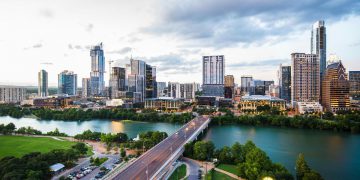
Free Image via Unsplash
The West Coast of the United States, with its sprawling beaches, towering forests, and bustling metropolitan areas, offers a unique blend of natural beauty and urban sophistication. But what’s it really like to call this diverse region home? Whether you’re drawn by the allure of vibrant city life or the promise of serene landscapes, moving to the West Coast could be the adventure you’re looking for.
A Guide to Major West Coast Cities
From the tech hubs of California to the coffee-scented streets of Seattle, each city on the West Coast has its own character, challenges, and hidden gems. Here’s a closer look at what each major city offers to prospective movers, home seekers, and urban explorers.
Seattle, Washington

Overview: Known affectionately as the Emerald City, Seattle is celebrated for its vibrant mix of outdoor adventures, thanks to its unique location nestled between the majestic Cascade Mountain range and the expansive waters of the Puget sound and surrounding creeks. The city’s cost of living is 50% higher than other US cities, mirroring the elevated average salaries, particularly in the burgeoning tech sector and other rapidly growing industries.
Moving Challenges: When preparing to move to Seattle, brace yourself for its infamous rainy weather; finding a residence with effective insulation and a robust heating system will be crucial for your comfort. Additionally, navigating parking in the bustling city center can prove to be a formidable challenge, requiring patience and may mean exploring public transportation options.
Things to Do: Seattle is a treasure trove of attractions, ranging from the iconic Space Needle, offering breathtaking views of the city and beyond, to the lively Pike Place Market, where the freshest produce and unique artisanal goods can be found. Seattle also boasts a plethora of world-renowned coffee shops, each with its own unique blend and ambiance, perfect for those looking to indulge in the local coffee culture. Outdoor enthusiasts will find solace in the city’s close proximity to nature, offering endless hiking, biking, and sailing opportunities.
Need to Know: Seattle’s technology scene is not only thriving but also redefining the global tech landscape, making it an exceptional place for innovation, startups, and networking within the tech community. The city’s forward-thinking culture fosters an environment where creativity and innovation can flourish, attracting tech professionals and entrepreneurs from around the world.
Portland, Oregon

Overview: With a unique and compelling motto like “Keep Portland Weird,” Portland invites expectations of a city bursting with character, where excellent food scenes thrive, and a strong sense of community prevails. While the cost of living here is only 24% higher than other major U.S. cities, the quality of life residents experience is notably high. This balance makes Portland an attractive place for people seeking a vibrant urban lifestyle without the exorbitant expenses.
Moving Challenges: Much like its Pacific Northwest neighbor, Seattle, Portland grapples with its share of rainy weather. The constant drizzle and downpour become a daily aspect of life, making waterproof gear not just a necessity but a way of life for those who choose to move here. Whether it’s jackets, boots, or umbrellas, being prepared for the weather is key to enjoying the city to the fullest.
Things to Do: Portland is a paradise for foodies and craft beer enthusiasts, offering an eclectic mix of culinary experiences and a thriving brewery scene that is hard to match. Beyond the urban delights, nature lovers will find themselves enamored with the easy access to breathtaking hiking trails and lush parks that dot the landscape around the city. Dog lovers will find no shortage of options for activities with their fur babies. From the iconic Forest Park to the serene Japanese Garden, there’s no shortage of natural beauty to explore.
Need to Know: Portland places a significant emphasis on sustainability and environmental consciousness, reflecting a citywide ethos that champions green living. This commitment is evident in its extensive recycling programs, investment in sustainable infrastructure, and the community’s overall lifestyle choices. Living in Portland means being part of a community that values and actively contributes to preserving the environment for future generations.
San Francisco, California

Overview: San Francisco, with its steep hills offering panoramic views, the iconic Golden Gate Bridge that presents a stunning backdrop to the city, and a vibrant cultural scene, is a marvel of the West Coast. It ranks at a whopping 79% higher cost of living than other cities in the U.S., a reflection of its desirability and the thriving economy. However, it compensates residents with high salaries, especially in the booming tech sector, making it a hub for innovation and success.
Moving Challenges: The cost of housing in San Francisco is exceptionally high, making it a significant hurdle for new residents. In addition to financial challenges, the city’s famous fog, affectionately known as Karl, can be a surprising element to those not accustomed to it. This unique climate feature, though often charming, requires an adjustment for newcomers.
Things to Do: San Francisco is filled with activities and sights to explore. Alcatraz Island offers a glimpse into the intriguing history of one of the most notorious federal penitentiaries in the U.S., now a fascinating museum. The city’s diverse culinary scene is a paradise for foodies, offering everything from high-end dining to authentic street food from around the world. For those seeking breathtaking views, a visit to Coit Tower on Telegraph Hill is a must, providing 360-degree vistas of the city and bay.
Need to Know: While San Francisco is widely recognized as a global tech haven, attracting talents and startups from around the world, it also boasts rich cultural experiences. The city is home to world-class museums, vibrant theaters, and a diverse music scene that caters to all tastes. This blend of technology and culture makes San Francisco a unique place to live, offering something for everyone, whether you’re an entrepreneur, artist, or someone who appreciates the beauty and diversity of life.
San Diego, California

Overview: San Diego, renowned for its idyllic weather and pristine beaches, presents a unique blend of laid-back atmosphere. Although it ranks at a 44% higher cost of living than other U.S. cities, it presents a lower cost of living compared to other bustling Californian cities like Los Angeles and San Francisco. This makes it a popular choice for those seeking the California dream without the exorbitant price tag.
Moving Challenges: Due to the city’s expansive layout, covering various neighborhoods and areas, having a car is almost indispensable. Public transportation exists, but it may not provide the convenience or coverage needed to easily explore or commute across the city.
Things to Do: San Diego is not just about relaxing beach days. It offers a vibrant nightlife with an array of bars and clubs, especially in the Gaslamp Quarter. For outdoor enthusiasts, the surfing opportunities are some of the best in the country. Additionally, the San Diego Zoo is a world-renowned attraction, hosting a vast variety of wildlife in meticulously crafted habitats, making it a must-visit for families and wildlife lovers alike.
Need to Know: San Diego’s status as a military hub, with several major Navy and Marine bases, significantly shapes the local economy and cultural landscape. This military presence brings a unique blend of diversity and community pride, with various military-related events and a strong support network for service members and their families.
Los Angeles, California

Overview: Los Angeles, often hailed as the entertainment capital of the world, needs no introduction. This vibrant city is the backdrop where countless dreams come to either flourish or falter under the Californian sun. At a 51% higher cost of living than most U.S. cities, it may be wise to budget and plan your living arrangements before you make your move. Los Angeles is more than just its glamorous facade; it offers an array of diverse neighborhoods, a melting pot of cultures from around the globe, and, indeed, its infamous traffic jams that can test the patience of even the most Zen individuals.
Moving Challenges: Those relocating to Los Angeles should brace themselves for a car-centric culture that dominates the city. Significant traffic congestion is a part of daily life, with rush hours turning highways into slow-moving rivers of metal. Finding alternative transportation routes and planning travel times accordingly can save newcomers from a lot of stress.
Things to Do: Los Angeles is a playground for the adventurous and the curious. Walk the Hollywood Walk of Fame and find the stars of your favorite entertainers, explore the vast collections of art at the Getty Center, and relax or play volleyball on the iconic Venice Beach. Beyond these, LA offers countless other experiences, from hiking in Griffith Park to catch a glimpse of the Hollywood sign, to exploring the diverse culinary delights in neighborhoods like Koreatown and Little Ethiopia.
Need to Know: While the entertainment industry remains the behemoth of Los Angeles, casting a long shadow across the city, LA’s economic landscape is varied and vibrant. The tech industry has been booming in what is now called Silicon Beach, while fashion, culinary arts, and other creative sectors offer many opportunities for professionals and enthusiasts alike. Navigating LA’s complex yet exciting professional scenes requires persistence and networking, but for those who make it, the city offers rewards beyond imagination.
Sacramento, California

Overview: Sacramento, the capital of California, contrasts sharply with its coastal counterparts by offering a more affordable cost of living (19% higher than the national average) while still ensuring access to the desirable Californian lifestyle. The median home price in Sacramento is significantly lower than in San Francisco or Los Angeles, making homeownership more attainable for many. Rent prices also tend to be more budget friendly. The average salary in Sacramento competes with that of other major cities, especially in sectors such as government, healthcare, and technology. This combination of accessible housing and competitive salaries makes Sacramento an attractive option for both professionals and families.
Moving Challenges: One of the main challenges of moving to Sacramento includes adjusting to the hotter, more inland climate, especially during the summer months where temperatures can soar. While the public transportation system, including buses and light rail, services the city, owning a car is highly beneficial for commuting and fully exploring the region.
Things to Do: Sacramento is rich in history and culture, home to the impressive California State Capitol, which offers free tours, and the historic Old Sacramento, a living monument to the Gold Rush era. The city embraces its agricultural roots with farm-to-fork dining experiences, thriving farmers’ markets, and renowned food festivals. Outdoor enthusiasts will appreciate the proximity to several parks and the American River Parkway, ideal for biking, walking, and recreational activities.
Need to Know: Sacramento’s role as the state capital imbues the city with a distinctive political and social dynamism, hosting numerous cultural events, festivals, and political gatherings that foster a strong sense of community. Additionally, its strategic location offers an advantage for those looking to explore the broader region, with easy access to the Sierra Nevada mountains, Napa Valley’s wine country, and being just a short drive from both San Francisco and Lake Tahoe.
Oakland, California

Overview: Oakland presents a unique mix of urban sophistication and natural beauty, nestled on the east side of the San Francisco Bay. While the cost of living in Oakland remains 46% higher than the national average, it is somewhat less than its neighbor, San Francisco, making it an attractive alternative for those seeking the Bay Area experience without the premium price tag. Median home prices and rents are notably lower, yet still reflect the competitive Californian housing market. Oakland’s economy is diverse, with growth in sectors such as technology, healthcare, and education driving competitive average salaries that aim to match the cost of living in the area.
Moving Challenges: Newcomers to Oakland may face challenges related to the city’s rapidly changing neighborhoods and housing availability. Gentrification has led to a significant shift in the character and cost of living in various areas, making some parts of Oakland more expensive than others. Additionally, navigating the city’s varying crime rates by neighborhood requires research and vigilance for those moving to the city. Traffic and parking can also be cumbersome, especially during peak hours, as is common in many urban settings.
Things to Do: Oakland is a city of vibrant culture, celebrated diversity, and extensive green spaces. It boasts an impressive arts scene, with murals, galleries, and live music venues dotting the city. Food enthusiasts will revel in Oakland’s culinary landscape, marked by innovative restaurants and a strong farm-to-table ethos. The city’s proximity to nature allows for a plethora of outdoor activities, including hiking in the nearby Redwood Regional Park, boating on Lake Merritt, and exploring the extensive Oakland Zoo.
Need to Know: Oakland is renowned for its social activism and rich cultural heritage, contributing to a strong sense of community pride and cohesion. The city’s history is deeply intertwined with significant political and artistic movements, which continue to influence its social fabric today. Understanding this context is key for anyone looking to become part of Oakland’s community. Additionally, Oakland serves as a critical transportation hub in the Bay Area, with extensive public transit options, including BART (Bay Area Rapid Transit), making it a convenient base for exploring the wider region.
Vancouver, Washington

Overview: Vancouver, Washington, offers a refreshing blend of urban and natural attractions, coupled with a more accessible cost of living (just 4% higher than the national average) compared to its neighboring city, Portland, Oregon. The median home price in Vancouver is attractive to those looking for affordable homeownership or rental options in the Pacific Northwest, with prices generally lower than in major cities along the West Coast. Vancouver’s economy benefits from a diverse job market, including sectors such as technology, healthcare, and manufacturing, contributing to competitive average salaries. This balance of affordability, job opportunities, and quality of life makes Vancouver an appealing choice for individuals and families alike.
Moving Challenges: One of the challenges newcomers may face when moving to Vancouver includes navigating the dual tax implications of living in Washington but potentially working in Oregon, leading to unique financial planning considerations. Additionally, while Vancouver is expanding its public transportation system, reliance on personal vehicles remains high, especially for those commuting across state lines. The weather, characterized by rainy winters and beautiful but short summers, may also require an adjustment period for those moving from sunnier climates.
Things to Do: Vancouver is steeped in history and natural beauty, offering residents plenty of opportunities to explore and engage. The city’s waterfront provides stunning views of the Columbia River, along with a growing number of restaurants and public spaces for community gatherings. Fort Vancouver National Historic Site offers a glimpse into the region’s past with its well-preserved grounds and interactive exhibits. Outdoor enthusiasts will enjoy the city’s proximity to the Columbia Gorge, Mount St. Helens, and the Pacific Coast, all of which provide ample recreational activities, from hiking to windsurfing.
Need to Know: Vancouver embodies a burgeoning community spirit distinctly its own, away from the shadow of Portland’s cultural scene. Its excellent schools, community-focused events, and overall quality of life are drawing more people to consider it a prime location for settling down. Vancouver’s strategic location also allows for ease of access to major transportation routes, including the Portland International Airport, facilitating travel and commerce. Understanding the unique blend of urban growth and commitment to preserving natural landscapes is key for those looking to join the Vancouver community.
Eugene, Oregon

Overview: Eugene, Oregon strikes a balance between urban amenities and the serenity of the Pacific Northwest’s natural landscape. Known for its environmental focus and as a haven for outdoor enthusiasts, Eugene offers a relatively affordable cost of living, 10% higher than the national average and relatively lower than larger West Coast cities. The median home price in Eugene presents an opportunity for both buyers and renters in search of value without sacrificing quality of life. The local economy is supported by sectors such as education, healthcare, and manufacturing, contributing to an average salary that aligns with the area’s cost of living.
Moving Challenges: Relocating to Eugene may bring challenges such as adapting to the city’s unique climate, with wet winters and dry summers. Additionally, the housing market, while more affordable on average, can be competitive, especially in desirable neighborhoods close to the University of Oregon. Newcomers might also need to adjust to a smaller city feel, finding their niche within Eugene’s close-knit community dynamics.
Things to Do: Eugene is rich in cultural and recreational activities. The city hosts an array of festivals, markets, and community events that display its vibrant arts scene and commitment to sustainability. Nature lovers can explore the endless trails, parks, and waterways, including the famed Willamette River, which runs through the heart of Eugene. The city’s emphasis on local agriculture is evident in its numerous farm-to-table restaurants and breweries, offering a taste of the region’s bounty.
Need to Know: Eugene’s identity is deeply rooted in environmental preservation and a strong sense of community activism. This ethos is reflected in the city’s planning, from extensive bike paths to initiatives promoting sustainability. For those moving to Eugene, understanding, and embracing this community spirit can greatly enhance the relocation experience. Additionally, the city’s status as a key educational hub, home to the University of Oregon, contributes to its youthful energy and innovative outlook, making it an engaging place to live, work, and play.
Santa Barbara, California

Overview: Santa Barbara, California, often referred to as the American Riviera, is renowned for its stunning Mediterranean climate, picturesque coastline, and upscale lifestyle. While the cost of living in Santa Barbara is notably high, at 54% above the national average, the region’s allure is undeniable. Home prices and rental rates are steep, reflecting the desirability of the location and its limited housing inventory. Despite this, the average salary in Santa Barbara is competitive, particularly in sectors such as technology, education, and healthcare, which dominate the local job market. This balance of high living costs with potentially lucrative employment opportunities makes Santa Barbara an attractive, though challenging, option for new residents.
Moving Challenges: The primary challenge for newcomers is the high cost of living, especially in the housing market where median home prices significantly exceed national averages. The limited availability of affordable housing can make it difficult for new residents to find suitable accommodation without significant compromise. Additionally, while Santa Barbara boasts a compact, accessible urban layout, traffic congestion can be a concern, particularly during tourist seasons and peak commute times.
Things to Do: Santa Barbara’s rich cultural heritage and natural beauty present a myriad of leisure and recreational opportunities. The city is home to numerous beaches, hiking trails, and wine valleys, offering endless opportunities for outdoor activities. Iconic historical sites such as the Santa Barbara Mission and the Courthouse provide a glimpse into the area’s past. The vibrant downtown area, with its array of shops, restaurants, and galleries, together with a thriving arts scene, ensures that residents and visitors can always find something to engage their interests.
Need to Know: For those considering a move to Santa Barbara, it’s important to go beyond its picturesque settings and consider the practicalities of daily life in a high-cost area. Engagement in the community and taking advantage of the outdoor lifestyle can significantly enhance one’s experience of living in this unique part of California. Additionally, the city’s concerted efforts in environmental conservation and sustainability are integral to its identity, appealing to those who value eco-conscious living. With its combination of natural beauty, cultural depth, and commitment to quality of life, Santa Barbara represents a distinctive, albeit pricey, place to call home.
Tips for Living on the West Coast
- Outdoor Adventure: Embrace the region’s breathtaking natural beauty to the fullest. Whether you’re trekking through lush trails, catching waves at pristine beaches, or gliding down snow-covered slopes, there’s an activity to satisfy every outdoor enthusiast’s craving.
- Cultural Immersion: The West Coast’s cities are melting pots of culture, offering a plethora of unique experiences. Dive deep into the heart of these communities by participating in local festivals, exploring vibrant markets, and engaging with art and traditions that span generations.
- Sustainability Practices: Renowned for its forward-thinking approach to environmental preservation, the West Coast leads by example in sustainability. You can contribute to the effort by joining local recycling initiatives, supporting eco-friendly businesses, and adopting practices that reduce your ecological footprint during your visit.
FAQs on Moving to the West Coast
Are people on the West Coast happier? Many residents appreciate the balanced lifestyle, access to nature, and vibrant cultural scenes, contributing to overall happiness.
How do people on the West Coast make a living? While technology and entertainment are dominant industries, there’s also significant employment in healthcare, education, and green jobs.
Where is the cheapest place to live out west? Cities like Eugene, Oregon, and Sacramento, California, offer more affordable living options without sacrificing the West Coast experience.
What Western state has the lowest cost of living? Generally, Oregon and Washington offer lower living costs compared to California, with certain cities standing out as particularly budget friendly.
Living on the West Coast is not just about enjoying the beautiful landscapes and cities; it’s about becoming part of a community that values diversity, innovation, and quality of life. Whether you’re drawn to the tech-savvy streets of San Francisco or the laid-back vibes of San Diego, the West Coast awaits with open arms and endless possibilities.
CubeSmart Offers Storage Solutions for New West Coast Residents
Moving to the West Coast? It’s an exciting time, but let’s face it, it comes with its fair share of challenges. That’s where we come in. At CubeSmart Self Storage we offer flexible storage options, whether you’re scaling down for a bit or need a place to store your things while you hunt for that dream home, or whether this is your first big intrastate move. We also offer features and amenities like moving truck rentals and packing supplies to make your move a little easier. Start enjoying your new West Coast lifestyle with a bit more peace of mind and confidence with added room at CubeSmart.







